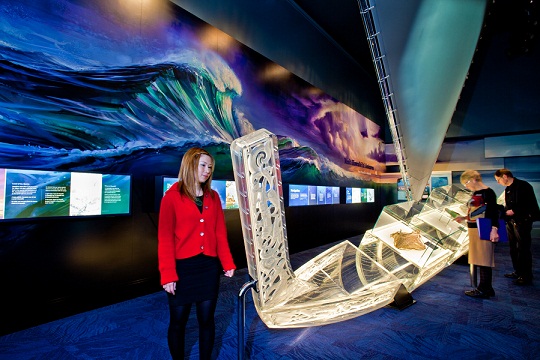Rotorua Historical Site Receives Waahi Tapu Status

Carved acrylic waka, David Hamilton Photography
ROTORUA, Thursday 8th March 2012: The Government Gardens at Rotorua have just been registered by the New Zealand Historic Places Trust and the Māori Heritage Council as a Waahi Tapu area.
The Waahi Tapu area, known as Paepaehakumanu Motutara, incorporates sacred remnants from pre-1900 buildings, swamps, cultivation areas and pa sites. The land was historically used as a bird snaring ground, which is where the name Paepaehakumanu is derived from.
The New Zealand Historic Places Trust provides Waahi Tapu status to those areas recognised by the Historic Places Act 1993 as sacred to Maori in the traditional, spiritual, religious, ritual or mythological sense.
Rotorua District Council director of Kaupapa Māori, Mauriora Kingi, acknowledges the rich history of the area and regards it in the highest esteem.
“A key feature of Paepaehakumanu Motutara is the hot pool chasm, now filled in, named Oruawhāta. The bodies of Te Arawa chiefs were buried in the ngāwhā (hot pools) to prevent desecration and pillaging by enemies. The area was also the backdrop of two historic tribal battles and consequently the land containing the remains of these ancestors is tapu (sacred),” he says.
Natural resources were gathered from the lake edge and swamp areas. Ngāwhā (hot pools) and mud pools also provided medicinal resources to local Māori. These geothermal areas of Paepaehakumanu Motutara are imbued with wairua (prestige) absorbed from centuries of spiritual use by the Arawa people.
In 1881, an agreement was reached between Te Arawa leaders and government agents, which resulted in an area of 50 acres created “for the benefit of the people of the world” (Hei oranga mo nga iwi katoa o te Ao). This later became the Government Gardens and has cemented the close bond between local government and Te Arawa.
Destination Rotorua Marketing general manager, Oscar Nathan says the Government Gardens are a key Rotorua attraction visited by thousands every year.
“Today the area includes a band rotunda, sports grounds, venues, tea rooms, The Blue Baths, Prince’s Gate archway and the famous Bathhouse, now home to the Rotorua Museum, which holds Category 1 Historical Building status.”
Rotorua Museum director, Greg McManus says the new Waahi Tapu status further heightens the significance of the current exhibition at the museum, which examines the history of the Arawa people.
“The signature exhibition Ngā Pūmanawa o Te Arawa – The Beating Hearts of Te Arawa follows the journey of the Arawa people, the original inhabitants of the area, from their homeland in Hawaiki to their descendants in Rotorua today,” explains McManus.
The acrylic waka (canoe) in the exhibition was created by Weta Workshop and represents the original Arawa waka. The carvings along the side of the transparent waka were designed by master carver Lyonel Grant with the team at Weta Workshop digitally carving his designs into the heavy-duty acrylic hull.
Sir Richard Taylor, managing director of Weta Workshop, said the installation was one of the most challenging jobs they have undertaken.
“It was a joy to be involved on this amazing project, working closely with the Rotorua Museum to create what we hope will be a lasting centrepiece to the Māori exhibition hall and a memorable contemporary approach to the masterful art of Māori carving and storytelling,” says Taylor.
loading...
loading...



No Comment »
1 Pingbacks »
[…] There is no news roundup on our website this week. We’re having some technical challenges, as the method of delivery of news items to us has changed, and we are still working out how to make the new online links available to members. This is in part a reflection of the fact that physical newspapers are in decline around the world as more of our news and information-gathering is sourced online. here is an example of a story about Rotorua Museum appearing in ‘Happyzine’. […]